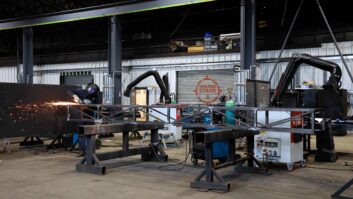
The advent of channel-in-a-box technologies – though it’s still early days – is part of the wider move to IT-centric infrastructure across the broadcast industry. Bringing capabilities that were once the exclusive remit of black box technologies into the software domain obviously presents challenges, but it is the logical way for the industry to evolve. This allows increased efficiencies while facilitating real innovation. The view of James Gilbert, Joint MD, Pixel Power.
At this stage there is no absolute single definition of channel-in-a-box technologies, rather the term means slightly different things to people. But in essence it is an integrated playout box, the goal being to pull together traditional playout functionality and workflow into a single integrated device therefore achieving lower total cost of ownership. Some define it as having to use off the-shelf-hardware but I think that it is a bit of an irrelevance as that is part of a separate trend in broadcast — the attempt to use more commodity components, again to drive costs down.
The critical thing about a channel-in-a-box solution has to be reliability and in order to achieve a reliable solution it is very likely going to deploy some custom electronics, at least in terms of I/O. We aren’t simply describing a server operation because the delivery from it is not yet an IP stream, though it could be; it is currently what we recognise as a broadcast stream. The question is really one of degree: how much custom technology do suppliers put in and how much do vendors add value to the broadcaster by doing so, be that hardware or software?
Channel-in-a-box technologies will, over time, offer the possibility of running multiple ‘simple’ channels through one integrated unit as processing power increases. This is an important potential cost-saver for the industry and another example of the advances that software offers.
As we all know, lower playout cost is an incredibly strong driver, especially at the moment, alongside ease-of-use and the advantage of single vendor contact. There is also the de-skilling potential in that if the box is capable of scheduling a channel completely automatically then a broadcaster needs less trained operators.
However there is a proviso to this. A trend that we are already seeing with some broadcasters is that they are required to shed expensive skilled staff, which can leave a skills shortfall. As equipment becomes more reliable, the time between failures lengthens and people become out of practice at knowing what to do. What broadcasters are doing at the moment is putting redundancy in by installing one or two more systems for a given number of channel-in-a-box installations. While this is fine for most occasions, it can cause problems with more complex failures. Vendors need to be alive to this issue and respond with comprehensive support programs.
There are also understandable compromises being made in the complexity of playout possible at the moment. One of the key determinants as to the suitability of a channel-in-a-box solution is how much live content a channel carries and how much manual intervention there needs to be. There is a line to be drawn with current channel-in-a-box technologies between canned and live content and how much of the latter they can handle.
In general these products rise to the challenge of HD though users – and vendors – need to be aware of the processing power required for HD graphics. To offer best-of-breed graphics with best-of-breed everything else in HD in a single box is currently pushing the technology to its limits, though it is easy to argue that this is simply the short-term price to pay for such innovation.
As the industry moves further down the IT – and therefore software – route, upgradability becomes easier. Indeed, if we take graphics as an example, there is decades of experience in this sector and that experience now manifests itself largely in the software domain with the market leaders. Channel-in-a-box technologies can take advantage of this, either by oversupplying functionality at the point of sale and then unlocking that over time, or by downloadable upgrades. All work that the channel really requires is being handled by the software. That is as it should be. If the industry’s going to reach a totally file-based, IT-centric position then all of the value and knowledge in broadcast workflows will end up being captured in the software IP.
For some time to come there will be the need for more complex workflows with manual intervention for more control where there is live content. Premium channels, news and sport will continue to require the traditional broadcast model and associated QoS, though of course this too is benefitting from the advances being made in the software domain.
Broadcasters are taking a very close look at what flexibility they need to pay for on which of their channels in order to reduce cost where they can. The other thing that we see in the market is that broadcasters still want a choice; the market will be mature when there is a host of reliable, enterprise-grade channel-in-a-box solutions from which broadcasters can pick.







